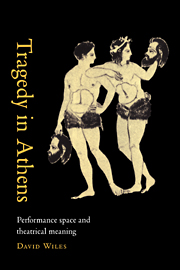Book contents
- Frontmatter
- Contents
- List of illustrations
- Acknowledgements
- List of abbreviations
- 1 The problem of space
- 2 The Theatre of Dionysus
- 3 Focus on the centre point
- 4 The mimetic action of the chorus
- 5 The chorus: its transformation of space
- 6 Left and right, east and west
- 7 Inside/outside
- 8 The vertical axis
- 9 The iconography of sacred space
- 10 Orchêstra and theatron
- Select bibliography
- Index
5 - The chorus: its transformation of space
Published online by Cambridge University Press: 06 January 2010
- Frontmatter
- Contents
- List of illustrations
- Acknowledgements
- List of abbreviations
- 1 The problem of space
- 2 The Theatre of Dionysus
- 3 Focus on the centre point
- 4 The mimetic action of the chorus
- 5 The chorus: its transformation of space
- 6 Left and right, east and west
- 7 Inside/outside
- 8 The vertical axis
- 9 The iconography of sacred space
- 10 Orchêstra and theatron
- Select bibliography
- Index
Summary
Theatrical space should not be understood as an empty receptacle waiting to be filled with a content of signs, but rather as a principle of organization. Anne Ubersfeld argues that in the proscenium theatre the principle of organization is based on the referent, the supposed real world replicated on stage. While a clear boundary divides the stage from the auditorium, the on-stage world and an imagined off-stage world are taken to be homogenous. In the ‘platform’ theatre, by contrast, organization is based on the spatial relationships visible to the spectator. The sharp boundary here is not the boundary which divides actor from audience, but the one which demarcates the platform stage from all that is unseen. In the proscenium theatre, Ubersfeld writes, ‘spatial organization is linked to the dramatic fiction, to the imagined space of which the scenic space is merely a concrete “translation”’, whereas in platform staging ‘space is organized in relation to the bodies of the actors who invest it’. The proportions of ‘mimesis’, where the emphasis is on the referent, the implied elsewhere, and ‘ludus’, where the emphasis is on the body of the performer, may change not only from play to play but also within a given play. In all forms of theatre, Ubersfeld argues, the mimetic and the ludic are present, and only the proportions change.
The task of the semiotician must include the diachronic exploration of spatial transformations, for the organization of space within a performance is rarely a constant.
- Type
- Chapter
- Information
- Tragedy in AthensPerformance Space and Theatrical Meaning, pp. 114 - 132Publisher: Cambridge University PressPrint publication year: 1997



